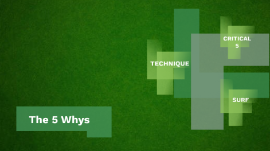5 whys
Transcript: 5 WHYs -a root cause analysis technique Origin of 5 Whys Origins part of the Toyota Production System, developed by Sakichi Toyoda one of the key factors for successful implementation of the technique is to make an informed decision. This means that the decision-making process should be based on an insightful understanding of what is actually happening on the work floor. =>> the root cause analysis process should include people with practical experience. 5 Whys in Action 5 Whys in action When applying the 5 Whys technique, you want to get to the problem's essence and then fix it. Actually, the 5 Whys may show you that the source of the problem is quite unexpected. Get Started How to Get Started with 5 Whys Try to assemble a team of people from different departments. By forming a cross-functional team, you are going to receive unique points of view. Discuss the problem with the team and make a clear problem statement. It will help you define the scope of the issue you are going to investigate. Empower one person to facilitate the whole process. The facilitator should ask “Why” as many times as needed until the team can identify the root cause of the initial problem. Don’t ask too many Whys. If you keep going, you may end up receiving tons of unreasonable suggestions and complaints, which is not the purpose. Sometimes there could be more than one root cause. In these cases, the 5 Whys analysis will look more like a matrix with different branches. All members should be involved in a discussion to find and apply the best solution that will protect your process from recurring problems. When the decision is made, one of the team members should be responsible for applying the right actions and observing the whole process. After a certain period of time, the team needs to meet again and check if their actions actually had a positive impact. If not, the process should be repeated.In the end, the case should be documented and sent across the organization. Takeaways Important Things to Remember You can work backward to ensure that you have the correct answer for each ” Why”. Differentiate causes from symptoms Always base your answers on facts and data It is possible to break down your answers however many times you wish. The more you can answer, the better Last, but not least, evaluate the process and not the people "The average business analyst will gather requirements, a good business analyst will elicit requirements, but a great business analyst will truly understand the reasons behind the requirements."

















